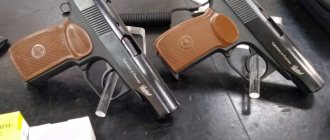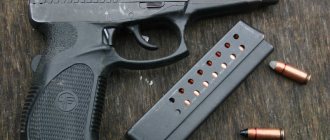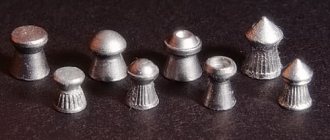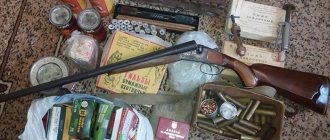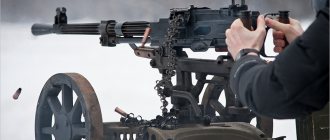| .366 TKM | |
| Certification parameters .366 TKM | |
| Manufacturer country | Russia, Russia |
| Cartridge | .366 TKM |
| Type of weapon using cartridge | carbine |
| Service history | |
| Operating time | 2015 - present |
| Used | Russia, Russia |
| Production history | |
| Years of production | 2015 - present |
| Options | lead in polymer, half-shell, shell |
| Characteristics | |
| Bullet weight, g | 13.5 grams “Dary” bullet 13.5 grams “SP13” bullet 15.5 grams “Gexa” bullet |
| Bullet energy | 1800-2500 J |
| Sleeve parameters | |
| Case shape | conical |
| Sleeve length, mm | 37,50 |
| Case neck diameter, mm | 9,58 |
| Sleeve base diameter, mm | 11,35 |
.366 TKM
(9.5x38) is a hunting cartridge developed in Russia for smooth-bore weapons with a partially rifled barrel (“Paradox”), or a rifled nozzle of the “Paradox” type, as well as barrels with Lancaster drilling. The first hunting cartridge developed in Russia since 1991 and put into large-scale production (other currently produced cartridges were put into production during the existence of the USSR).
The ammunition is designed for use in long-barreled smoothbore weapons. A special feature of the ammunition is its design, thanks to which its ballistic characteristics bring the cartridge closer to analogues for rifled weapons. This convergence is unique for the Russian ammunition market and the global market as a whole.[1][2][3][4] From the point of view of the legislation of the Russian Federation, this cartridge is a cartridge for smooth-bore weapons.
The caliber of the cartridge is indicated in fractions of an inch, the abbreviation “TKM” means the developers of the cartridge-weapon complex - Tekhkrim CJSC, (Izhevsk [ TK
]) and JSC VPMZ "Molot" (Vyatskie Polyany).
To use ammunition, the design of the weapon must provide for the use of a “Paradox” type nozzle or a rifled part of the barrel bore with a length of no more than 140 mm. The cartridge is positioned in the chamber of the weapon according to the barrel (by analogy with pistol cartridges).
The cartridge is based on the 7.62×39 cartridge case. 1943. Although the reloading of this cartridge is permitted by Russian legislation (since the type of cartridge relates to cartridges for smooth-bore weapons), the lack of mass production of matrices for its equipment significantly complicates this process.
Designed for hunting animals weighing up to 200 kg at distances up to 150-200 meters, training shooting and self-defense. Ballistic characteristics allow you to confidently hit:
- chest figure - at a distance of up to 150 meters (trajectory drop when zeroing a weapon at 100 m - 16 cm, bullet energy 1250, bullet dispersion diameter ~ 300 mm);
- a tall figure at a distance of up to 200 meters (trajectory drop when zeroing a weapon at 100 m is 45 cm, bullet energy is 1080 J, bullet dispersion diameter is ~400 mm). [ source not specified 577 days
]
The manufacturer and developer of the cartridge is Tekhkrim CJSC. The holder of the patent for the cartridge is Tekhkrim CJSC.
Content
- 1 Weapon chambered
- 2 Metric caliber designation
- 3 Specifications
- 4 General assessment of the cartridge 4.1 Area of application
- 4.2 Distances 150–300 m
- 4.3 Distances from 50 m to 150 m
- 4.4 Product quality
- 4.5 Cost on the Russian market
- 5.1 Primary problems
Weapon chambered
Weapons in this caliber as of the end of 2020 in mass production are represented by samples based on re-barrel SKS and AKM from VPMZ "Molot" - VPO-208 and VPO-209, as well as hunting carbines VPO-212 and VPO-213 produced from scratch, respectively . produces hunting carbines AK-366, AKS-366, SKS-366, which are re-barrel samples of the corresponding carbines, on barrels with Lancaster drilling. The Kalashnikov Concern produces the Kalashnikov TG2 smoothbore self-loading shotgun based on the Saiga self-loading carbines[5].
Review of the popular Saiga-TG2 carbine and its key features
Famous not only in Russia, but throughout the world, the Kalashnikov concern has donated many excellent examples of firearms, rifled and smooth-bore. We are talking not only about the well-known AKM, but also about carbines designed for:
- hunting in commercial areas;
- recreational shooting at a specially equipped range;
- sports shooting.
A striking example is the Saiga-TG2 self-loading smoothbore carbine, the creation of which was the responsibility of the weapons department. He is the official dealer of the Kalashnikov concern, and therefore has adopted the tradition of creating high-quality, convenient and reliable weapons.
Self-loading carbine chambered for .366 TKM
Considering the TG2 carbine, designed for the 366 TKM cartridge, one cannot help but notice the striking similarity with the AK103. This smoothbore gun completely replicates the famous machine gun in both ergonomics and design. However, it does not have such high power and is completely adapted for civilian weapons, which can be purchased under a smoothbore license.
The resemblance to the AK103 is truly striking. An authentic hunting rifle is similar to a machine gun in almost all respects:
- weight;
- ergonomics;
- appearance.
In appearance, the Saiga TG2 resembles the AK-103
Of course, the designers of the concern also applied many developments regarding the mechanism. They used automatic recharging technology based on:
- principle of removal of powder gases;
- return spring.
The shooter does not need to worry about reloading the weapon every time. But the Saiga-TG2 is not suitable for burst fire: only single shots, and after each shot the carbine is put on safety. This makes the weapon safe, and also fits the carbine into the current legislation.
Of course, Saiga TG2 is attractive to buyers primarily due to its authentic design, but it also has considerable advantages, which include:
- Reliable handling. This indicator is very important because it simplifies the care of the weapon and allows it to be used even in adverse weather conditions, including dampness, severe frosts, and so on.
- Folding stock. This greatly simplifies the transportation of the carbine, as it reduces its dimensions. Of course, if desired, the owner can completely disassemble the gun into its component parts, which allows it to be placed in a special case. However, this takes a lot of time. By folding the stock, you can even place the carbine in a small bag. Please note that the Saiga-TG2 is equipped with a safety lock that prevents firing with the stock folded.
- Spacious store. We are talking about a familiar horn, but its capacity is 10 rounds, which corresponds to the letter of the law. Let us remind you that many smooth-bore self-loading shotguns, including the Vepr series, are designed to hold 4-5 rounds in the magazine.
- Picatinny rail. This expands the possibilities for installing additional accessories: bipod, flashlight, tactical handle, and so on.
- Muzzle compensator. We are talking about a removable muzzle brake, which makes shooting from weapons of 366 TKM caliber much more comfortable and enjoyable.
Folding stock makes it easy to transport the carbine
It may seem that the Saiga-TG2 is unsuitable for direct hunting due to its shape, and indeed, many shooters prefer guns in a more traditional form factor. However, it is worth noting that the TG2 has a side rail that allows you to install additional sights, including a collimator and optics.
Characteristics of the carabiner
It's time to look at the exact numbers and get to know the parameters of the Saiga-TG2 smoothbore carbine. We are talking about the following data:
- total length - 945 mm (with the butt folded - 705 mm);
- barrel length - 415 mm;
- weight without cartridges - 3.6 kg.
The carbine has relatively small dimensions and a rather short barrel. On the one hand, this reduces the energy of the shot and the initial speed of the bullet. On the other hand, a balanced and thoughtful design allows for effective targeted shooting at a distance of 100 meters.
To make the Saiga-TG2 carbine, manufacturers decided to use not only heavy-duty steel, but also polymers. They went to create:
- butt;
- pistol grip;
- forend.
The butt, fore-end and handle are made of military plastic
Firstly, it helped reduce the weight of the gun to an affordable 3.6 kg. Secondly, it significantly improved the design, making this weapon much more serious.
Components of TG2
Everything here is quite simple and trivial for a smoothbore weapon of this type. The key structural element is the receiver assembly with the barrel. Other main details include:
- gas tube;
- return mechanism;
- trigger;
- shutter (assembled);
- trigger (assembled).
Saiga TG2 bolt and receiver
In addition, a forend, muzzle brake, butt and magazine are installed on the carbine.
As for the issue of cost, it is very interesting. The concern managed to create an excellent example of modern weapons, available to almost every smoothbore license holder. From this point of view, Saiga-TG2 bypasses many samples of the Molot-Weapon enterprise.
Prices for the Saiga smoothbore carbine are quite affordable for the average hunter
The average cost of TG2 on the Russian market is approximately 33 thousand rubles. As for the 366 TKM caliber ammunition, it is quite affordable for both hunters and recreational shooting enthusiasts.
Metric caliber designation
The metric designation is made in accordance with the rules for designating the caliber of Soviet rifled weapons, where the first number designates the caliber by field, not by rifling, and the second number indicates the length of the cartridge case reduced to the nearest whole value. Thus, with an actual bullet diameter of 9.53-9.58 mm, the caliber of the barrel of the VPO-208 carbine is 9.50 mm in the smooth section, and in the rifled part 9.40 mm along the rifling and 8.90 mm along the rifling fields. The sleeve length is 37.5 mm. Since the main section of the barrel is smooth with a diameter of 9.50 mm, in the metric system this caliber can be designated as 9.5 × 38 mm (rounded up). Or by analogy with the .410/76 cartridge as .375/38 mm.
How are sporting cartridges made?
The technologies used in the production of hunting cartridges are not too different from the technologies that are used to produce cartridges for clay pigeon shooting. The main difference lies in the unusual design of such a cartridge element as wads. It is thanks to the unique design that it is possible to achieve optimal shot scattering for individual disciplines.
The diameter of the shot for the cartridge should not exceed 2.5 mm, and the entire sample of shot should not exceed 28 grams in weight. For sports shooting training, shot No. 7.5, or smaller shot No. 8 and No. 9, can also be used. The shot weight of cartridges for Olympic skeet shooting disciplines is 24 grams. As for sporting, the same weight of 28 grams is used here. There are also cartridges for training or for competitions among juniors. The main difference between these cartridges is the reduced weight of the shot, it is 20 grams. This modification allows for long-term skeet shooting training.
You can buy cartridges both from domestic manufacturers and from importers. Among imported cartridges, cartridges from such manufacturers as RC, Fiocchi, Clever (Italy) are very popular. Cartridges from these manufacturers are most often used by professional athletes. Because only thanks to them it is possible to obtain stable performance and combat characteristics, which is especially important at important sports competitions.
Specifications
- Barrel caliber: 9.50 mm or 0.374 inches. The caliber is named ".366TKM" for the reason that the .366 caliber cartridge was first certified, but after experiments and tests it was decided to increase the barrel caliber to 9.50 mm and the bullets to 9.58 mm (.377 in) without changing the name .
- Sleeve length: 37.5 mm.
- Bullet weight: from 8 to 15 g.
Characteristics obtained when shooting from the VPO-208 carbine (based on SKS):
- For a lead bullet with an anti-friction polymer coating:
- Bullet weight: 13.5 g.
- Initial bullet speed: up to 530-550 m/s.
- Initial kinetic energy: 1895-2040 J.
- The diameter of the dispersion of bullets when shooting from a ball. barrel at a distance of 100 m: 50 - 80 mm.
- Dispersion radius from the VPO-208 carbine with an optical sight, from a sitting position, from a rest, at a distance of 100 m: about 100mm
- For jacketed and semi-jacketed bullets:
- Bullet weight: 15 g.
- Initial bullet speed: up to 570-590 m/s.
- Initial kinetic energy: 2440-2610 J.
- The radius of dispersion of bullets when shooting from bal. barrel at a distance of 100m: 50 - 80 mm.
Review of the TG2 smoothbore hunting rifle
Weapons center Temp is the official dealer of the Kalashnikov Concern, and presents for sale a new smoothbore shotgun TG2 chambered for 366 TKM, created on the basis of the Kalashnikov AK103 assault rifle and authentic to its military counterpart in ergonomics, weight and appearance. The new gun is available for purchase under a shotgun license.
The weapon is equipped with a trigger blocker, which makes it impossible to shoot with the stock folded. The safety lever is made with an additional protrusion near its axis, specifically for the shooter's index finger.
The gun has a side rail for mounting optical and collimator sights
The sights are authentic to the AK103 assault rifle. The barrel is equipped with a removable muzzle brake compensator on a standard M24x1.5 thread (right).
It is equipped with a magazine with a capacity of 10 rounds in an elongated body.
The TG2 shotgun has a gas-operated system and is equipped with a folding stock, a handle, and a forend with a Picatinny rail made of impact-resistant polymer, similar to Kalashnikov combat assault rifles.
Why might this gun be of interest to Russian shooters?
Firstly, the TG2 gun is structurally and externally as authentic as possible to the Kalashnikov AK103 combat assault rifle. This means not only the familiar characteristic appearance and design, but also the high strength and reliability of the weapon, and ease of operation.
Secondly, thanks to the combination of .366TKM bullet cartridges, which have high energy and good ballistics, with a forged chrome-plated barrel of a TG2 gun and a proven drill, “Paradox” allows you to achieve characteristics in terms of accuracy and effective shooting range, previously possible only with rifled weapons. With an initial speed of a 15-gram bullet of about 600 m/s, this gives a muzzle energy of about 2700 Joules - significantly more than that of a 7.62x39 cartridge bullet. Moreover, at a range of 150 meters, such a bullet with a nominal caliber of 9.65mm maintains a speed of about 430 m/s, which gives the bullet energy at this range more than 1300 joules. This is enough to successfully catch most of the medium and even some large game found in Russia. The characteristics of accuracy and accuracy of fire from the TG2 allow targeted fire up to 150 meters, which may be of interest to sports shooters.
Thus, the combination of the TG2 smoothbore shotgun and .366TKM cartridges gives Russian shooters an excellent equivalent of a fairly powerful and reliable self-loading carbine for both hunting and sporting training shooting, without having to wait 5 years to obtain a rifle license.
You can purchase this gun by visiting our TEMP Weapons Center in Podolsk; we recommend that you leave a reserve on our website before visiting us.
You can also purchase all kinds of tuning and various unlicensed accessories on the second floor of our store, or order them for delivery throughout Russia.
Overall cartridge rating
The designers managed to create a weapon-cartridge complex that allows self-loading fire and successfully hitting targets at ranges of about 100-150 m, with a good stopping effect, which is due to the bullet of a larger caliber compared to the basic “7.62×39” rifled cartridge and bullet mass. The main achievement and innovation of the cartridge is its convergence in ballistic characteristics with cartridges for rifled weapons, which opens up new opportunities in purchasing and collecting smooth-bore weapons and expanding their combat potential. In particular, thanks to the use of this cartridge in a cartridge-weapon complex, it is possible to improve the characteristics of the complex without the need to spend money on more expensive rifled analogs and wait to obtain a license to purchase rifled weapons.
Application area
The area of rational use of the new weapon-cartridge complex is driven hunting for small and medium-sized ungulates, where increased accuracy and accuracy at long distances and high stopping power of a 12-gauge weapon are not required.
Distances 150-300 m
At distances over 150 m and up to 300 m, the new cartridge is inferior to traditional rifled cartridges (including the basic 7.62×39) in terms of speed and flatness of trajectory (the drop in trajectory is much greater) [ source not specified 577 days
], but surpasses the 7.62×39 caliber in terms of energy and bullet impulse (in particular, with factory cartridges with the “Cone” bullet and self-loaded cartridges with imported semi-jacketed bullets of .375 caliber) and in these parameters approaches the cartridges 308 Vin" and 7 ,62×54R.
It should be noted that the new caliber .366TKM is in many ways an analogue of the Soviet 9.3×53R (So the .366TKM is capable of accelerating a bullet weighing 15 g to 625 m/s, while the “9.3×53” accelerates a bullet weighing 15 g up to 650 m/s). Shooting the carbine with homemade cartridges with high-quality imported .375″ caliber bullets showed that despite the smooth section of the barrel, the carbine’s accuracy is not completely inferior to its rifled counterparts and even surpasses its ancestors - the SKS and AKM. Apparently, this is due to the fact that rifled carbines (civilian) often have a barrel that has already been shot and damaged by cleaning with a steel ramrod, as well as a pin driven and welded into the barrel bore - a crimping mark. [ source not specified 577 days
] Carbines of caliber 366TKM, manufactured at enterprise VPMZ "Molot", have a new chrome-plated barrel, forged on modern equipment.
Distances from 50 m to 150 m
At short distances (up to 50 meters) with comparable accuracy and accuracy of fire to a smoothbore (with the best 12-gauge sub-caliber bullets, such as “Brenneke” and Polev), the .366TKM cartridge is significantly inferior to it in stopping effect: the bullet diameter is half as large - 9 .4 mm (gauge by lobe) versus 18.4 mm; weight - 13.5-16.25 g versus 36-42 grams. However, at distances over 100 m, the .366TKM caliber is already superior to the 12th gauge in all respects.
Product quality
The low quality of ammunition sold in stores may raise questions regarding primary safety when hunting large game. A cartridge of this caliber is produced by only one company, so if the production of cartridges ceases, the buyer of the carbine may be left without factory-produced ammunition. Independent reloading of cartridges is possible, but difficult: firstly, you will need a decapsulator for cartridges with a Berdan capsule or stretching of imported brass cartridges of 7.62×39 caliber with a Boxer capsule; secondly, for use in semi-automatic weapons, it is necessary to crimp the cartridge case before reloading, to return it to the factory dimensions (for smooth-bore cartridges it is also necessary, with the exception of brass cartridges used in double-barreled and single-barreled guns, but we are talking about semi-automatic weapons). This type of crimping, called “Fullsize”, is required by any semi-automatic and automatic weapon. This requires special dies and a press. The press is currently expensive, but it is quite possible to buy it, however, only a few private individuals make dies for the .366TKM caliber and, due to piece production, their price is very high.
Cost on the Russian market
The cost of the cartridge is relatively high, approximately twice the price of a basic 7.62×39 rifled cartridge.[6]
The cost of the VPO-208 carbine chambered for .366TKM is also twice the cost of the basic SKS carbine. [ source not specified 577 days
]
Saiga-366 smoothbore shotgun, caliber 366 TKM
Self-loading smoothbore shotgun Saiga-366
Saiga-366 shotgun at the ARMS & Hunting 2016 exhibition. Photo mgewehr42.livejournal.com
The Saiga-366 self-loading smoothbore shotgun, developed by the Kalashnikov Concern on the basis of the AK-74, is equipped with a smooth Paradox-type barrel with rifling in the muzzle with a rifling section length of 120 mm and fires .366 TKM cartridges.
The gun is equipped with a metal frame stock that folds onto the left side, like the AKS-74. There is a firing lock when the stock is folded. The handguard, the gas tube receiver and the pistol fire control grip are made of plastic. For mounting optical, night and collimator sights on the left side of the receiver there is a standard dovetail side rail. The Saiga-366 shotgun is fed with cartridges from extended magazines with a capacity of 10 rounds.
The Saiga-366 gun was first shown to the public at the Army 2016 exhibition in September 2020. The exhibition sample had a mock-up of a four-slit muzzle brake. At the Moscow International Exhibition “ARMS & Hunting - 2016” the Saiga-366 shotgun was equipped with a mock-up of the standard AK-74 muzzle brake-compensator. The specimen shown at the exhibition did not have a cartridge feed ramp (feed guide / so-called “cracker”), which increases the reliability of feeding from the magazine into the chamber of all types of civilian cartridges, including cartridges with semi-jacketed bullets.
A long-barreled, single-barreled, self-loading hunting shotgun, Saiga-366, caliber .366 TKM, can be purchased with a smooth-bore license, without waiting for the end of the five-year period before obtaining permission to own a rifled weapon.
The .336 TKM cartridge is designed for hunting animals weighing up to 200 kg. at distances up to 150 meters. The abbreviation “TKM” means the developers and, Izhevsk (TK) and OJSC “Molot”, Vyatskie Polyany. The .336 TKM cartridge is made on the basis of the 7.62×39 mm cartridge case. 1943. The caliber of the cartridge is indicated in fractions of an inch, the dimensions in the metric system are as follows: 9.5 × 37.5 mm.
Cartridges of caliber .366 TKM are produced with a lead bullet "Dary" weighing 13.5 g and with a semi-jacketed bullet "Gexa" weighing 15.5 g, and since 2016 the production and sale of a cartridge with a semi-jacket bullet "Konus" weighing 15 g has been resumed, then Serial production of a cartridge with a semi-sheathed SP 13 bullet weighing 13 g has also begun.
Automatic reloading of the Saiga-366 shotgun is carried out by using the energy of the powder gases removed from the barrel bore into the gas chamber when fired, and the energy of the return spring. The bolt is locked onto two lugs by rotating the bolt around its axis using a longitudinally sliding bolt frame. The hammer-type trigger mechanism allows firing only single shots, as well as setting the safety on. The trigger is made non-removable. The gun is equipped with open mechanical sights similar to the AK-74 with markings on the sighting bar up to 1000 meters.
Operating principle of Saiga-366
The operating principle of the Saiga-366 smoothbore shotgun is as follows: when the bolt frame and bolt move forward under the action of the return spring, a cartridge from the magazine is sent into the chamber. When the bolt is turned, the barrel bore is locked, the trigger is on the trigger hook, and the ejector jumps over the rim of the cartridge case. When you press the trigger, the trigger disengages from the trigger hook and, turning under the action of the mainspring, delivers an energetic blow to the firing pin, which pierces the igniter capsule.
A shot occurs. When the bolt frame with the bolt rolls back due to the energy of the powder gases, the barrel bore is unlocked, the cartridge case is removed from the chamber and, when interacting with the protrusion of the reflector, it is thrown out of the receiver, the hammer rotates and engages with the sear. When the trigger is released, the hammer disengages from the sear and is intercepted by the trigger hook. When the trigger is pulled again, the cycle repeats.
The Saiga-366 shotgun will be available for purchase in the fall of 2020. Expected price – from 20 thousand rubles.
Technical characteristics of the Saiga-366 shotgun
- Caliber: .366 TCM
- Weapon length: 945 mm / 705 mm (with stock folded)
- Barrel length: 415 mm
- Weight without cartridges: 3.6 kg
- Magazine capacity: 10 rounds
Patron criticism
Primary problems
During the production of this ammunition, I encountered numerous technological problems. [ source not specified 577 days
] As a result, in the first six months of production, numerous customer complaints were noted about the quality of the ammunition produced by the company. [
source not specified 577 days
] The problem was that oil got into the gunpowder of the cartridges, which led to a firecracker shot, which is why the bullet might not have enough energy to leave barrel, and if it was not removed from the barrel bore after the shot, then a subsequent shot could lead to a rupture of the barrel. [
source not specified 577 days
] Even if the bullet left the barrel, the energy of the powder gases was not enough for the correct operation of the automatic gas control system, therefore , the carbine did not reload.
After numerous complaints, the manufacturer acknowledged this problem and fixed it. [ source not specified 577 days
]
Problems with the SP13 bullet
As ammunition with new semi-jacketed bullets was introduced into production, new problems arose: the SP13 bullet had an increase in the diameter of the lead core, which led to an increase in the overall diameter of the bullet, and, as a result, the impossibility of its correct operation. This problem has been recognized by the manufacturer, and according to the statement, cartridges produced in 2017 will be free of this problem. [ source not specified 577 days
] Indeed, this problem was solved in 2020 by making changes to the technological process, but a new one arose - cases of a bullet getting stuck in a paradox again appeared. Numerous complaints about the quality of ammunition from the monopoly cartridge manufacturer are holding back the spread of this cartridge on the market and limiting the use of factory-made ammunition in the course of life.
What cartridges cannot be used in skeet shooting competitions?
At skeet shooting competitions, the use of black powder for cartridges or the use of incendiary and other special substances is not permitted. It is also prohibited to modify cartridges and use technologies that give a dispersion effect. Also, the competition rules prohibit the use of a reverse charging sequence for components that intersect with the partition.
Skeet cartridges are designed for smooth-bore weapons. These cartridges are used for firing at moving targets (skeet), for competitions you must select an equipped shooting range. Cartridges for sports shooting can be used both in competitions and for training athletes in training. The following requirements apply to such cartridges:
- The cartridges must allow for stable pellet flight performance.
- The cartridges must ensure uniform shot fall.
- The cartridges should give a comfortable recoil when firing several shots in a row.
Development of the cartridge
Currently, work is underway to create a similar cartridge based on a 7.62x54R rifled cartridge case for hunting large animals. It is expected that the characteristics of the new cartridge will be close to the characteristics of the 9.3x53R rifled cartridge for driven hunting. It is assumed that higher energy will be able, in part, to offset the insufficient accuracy of weapons with a partially rifled barrel - since for driven hunting, where shooting is usually carried out at a short distance, hand-held, at a fast-moving target, high accuracy from the weapon-cartridge complex not required, but a good stopping effect is required.
Notes
- New caliber .366 TKM "Tekhkrim" all the details. And further development. | Weapons Club (Russian). gunsmiths.ru. Retrieved March 20, 2017.
- A new weapon has been released: an undercut or a shotgun of .366 TK caliber - Okhotniki.ru. www.ohotniki.ru. Retrieved March 20, 2020.
- VPO-208: non-standard “paradox” (Russian), Siberian hunter
. Retrieved March 20, 2020. - Paradoxical reality (Russian). KALASHNIKOV. Retrieved March 20, 2020.
- kalashnikov (Russian). ak.kalashnikovgroup.ru. Retrieved June 6, 2018.
- Price list for Tekhkrim ammunition

